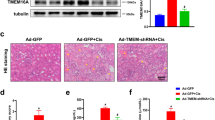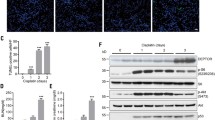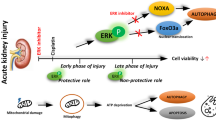Abstract
Tubular cell apoptosis significantly contributes to cisplatin-induced acute kidney injury (AKI) pathogenesis. Although KCa3.1, a calcium-activated potassium channel, participates in apoptosis, its involvement in cisplatin-induced AKI is unknown. Here, we found that cisplatin treatment triggered an early induction of KCa3.1 expression associated with HK-2 cell apoptosis, the development of renal tubular damage, and apoptosis in mice. Treatment with the highly selective KCa3.1 blocker TRAM-34 suppressed cisplatin-induced HK-2 cell apoptosis. We further assessed whether KCa3.1 mediated cisplatin-induced AKI in genetic knockout and pharmacological blockade mouse models. KCa3.1 deficiency reduced renal function loss, renal tubular damage, and the induction of the apoptotic marker caspase-3 in the kidneys of cisplatin-treated KCa3.1 −/− mice. Pharmacological blockade of KCa3.1 by TRAM-34 similarly attenuated cisplatin-induced AKI in mice. Furthermore, we dissected the mechanisms underlying cisplatin-induced apoptosis reduction via KCa3.1 blockade. We found that KCa3.1 blockade attenuated cytochrome c release and the increase in the intrinsic apoptotic mediators Bax, Bak, and caspase-9 after cisplatin treatment. KCa3.1 blocking inhibited the cisplatin-induced activation of the endoplasmic reticulum (ER) stress mediator caspase-12, which is independent of calcium-dependent protease m-calpain activation. Taken together, KCa3.1 blockade protects against cisplatin-induced AKI through the attenuation of apoptosis by interference with intrinsic apoptotic and ER stress-related mediators, providing a potential target for the prevention of cisplatin-induced AKI.




Similar content being viewed by others
References
Chen M, Sun HY, Hu P et al (2013) Activation of BKca channels mediates hippocampal neuronal death after reoxygenation and reperfusion. Mol Neurobiol 48:794–807
dos Santos NA, Carvalho Rodrigues MA, Martins NM, dos Santos AC (2012) Cisplatin-induced nephrotoxicity and targets of nephroprotection: an update. Arch Toxicol 86:1233–1250
Elliott JI, Higgins CF (2003) IKCa1 activity is required for cell shrinkage, phosphatidylserine translocation and death in T lymphocyte apoptosis. EMBO Rep 4:189–194
Freise C, Querfeld U (2014) Inhibition of vascular calcification by block of intermediate conductance calcium-activated potassium channels with TRAM-34. Pharmacol Res 85:6–14
Ghanshani S, Wulff H, Miller MJ et al (2000) Up-regulation of the IKCa1 potassium channel during T-cell activation. Molecular mechanism and functional consequences. J Biol Chem 275:37137–37149
Grgic I, Kiss E, Kaistha BP et al (2009) Renal fibrosis is attenuated by targeted disruption of KCa3.1 potassium channels. Proc Natl Acad Sci USA 106:14518–14523
Kashio Y, Nakamura K, Abedin MJ et al (2003) Galectin-9 induces apoptosis through the calcium-calpain-caspase-1 pathway. J Immunol 170:3631–3636
Kaushal GP, Kaushal V, Hong X, Shah SV (2001) Role and regulation of activation of caspases in cisplatin-induced injury to renal tubular epithelial cells. Kidney Int 60:1726–1736
Kawai Y, Nakao T, Kunimura N, Kohda Y, Gemba M (2006) Relationship of intracellular calcium and oxygen radicals to Cisplatin-related renal cell injury. J Pharmacol Sci 100:65–72
Khalid MH, Shibata S, Hiura T (1999) Effects of clotrimazole on the growth, morphological characteristics, and cisplatin sensitivity of human glioblastoma cells in vitro. J Neurosurg 90:918–927
Khalid MH, Tokunaga Y, Caputy AJ, Walters E (2005) Inhibition of tumor growth and prolonged survival of rats with intracranial gliomas following administration of clotrimazole. J Neurosurg 103:79–86
Kim YK, Jung JS, Lee SH, Kim YW (1997) Effects of antioxidants and Ca2+ in cisplatin-induced cell injury in rabbit renal cortical slices. Toxicol Appl Pharmacol 146:261–269
Kondratskyi A, Kondratska K, Skryma R, Prevarskaya N (2015) Ion channels in the regulation of apoptosis. Biochim Biophys Acta 1848:2532–2546
Krick S, Platoshyn O, Sweeney M et al (2002) Nitric oxide induces apoptosis by activating K+ channels in pulmonary vascular smooth muscle cells. Am J Physiol Heart Circ Physiol 282:H184–H193
Lang PA, Kaiser S, Myssina S, Wieder T, Lang F, Huber SM (2003) Role of Ca2+ -activated K+ channels in human erythrocyte apoptosis. Am J Physiol Cell Physiol 285:C1553–C1560
Lau AH (1999) Apoptosis induced by cisplatin nephrotoxic injury. Kidney Int 56:1295–1298
Lee EL, Hasegawa Y, Shimizu T, Okada Y (2008) IK1 channel activity contributes to cisplatin sensitivity of human epidermoid cancer cells. Am J Physiol Cell Physiol 294:C1398–C1406
Lieberthal W, Triaca V, Levine J (1996) Mechanisms of death induced by cisplatin in proximal tubular epithelial cells: apoptosis vs. necrosis. Am J Physiol 270:F700–F708
Liu H, Baliga R (2005) Endoplasmic reticulum stress-associated caspase 12 mediates cisplatin-induced LLC-PK1 cell apoptosis. J Am Soc Nephrol 16:1985–1992
Liu Y, Zhao L, Ma W et al (2015) The blockage of KCa3.1 channel inhibited proliferation, migration and promoted apoptosis of human hepatocellular carcinoma cells. J Cancer 6:643–651
Maeno E, Ishizaki Y, Kanaseki T, Hazama A, Okada Y (2000) Normotonic cell shrinkage because of disordered volume regulation is an early prerequisite to apoptosis. Proc Natl Acad Sci USA 97:9487–9492
Marklund L, Henriksson R, Grankvist K (2001) Cisplatin-induced apoptosis of mesothelioma cells is affected by potassium ion flux modulator amphotericin B and bumetanide. Int J Cancer 93:577–583
Marklund L, Andersson B, Behnam-Motlagh P, Sandstrom PE, Henriksson R, Grankvist K (2004) Cellular potassium ion deprivation enhances apoptosis induced by cisplatin. Basic Clin Pharmacol Toxicol 94:245–251
McFerrin MB, Turner KL, Cuddapah VA, Sontheimer H (2012) Differential role of IK and BK potassium channels as mediators of intrinsic and extrinsic apoptotic cell death. Am J Physiol Cell Physiol 303:C1070–C1078
Orrenius S, Zhivotovsky B, Nicotera P (2003) Regulation of cell death: the calcium-apoptosis link. Nat Rev Mol Cell Biol 4:552–565
Pabla N, Dong Z (2008) Cisplatin nephrotoxicity: mechanisms and renoprotective strategies. Kidney Int 73:994–1007
Pal S, Hartnett KA, Nerbonne JM, Levitan ES, Aizenman E (2003) Mediation of neuronal apoptosis by Kv2.1-encoded potassium channels. J Neurosci 23:4798–4802
Park MS, De Leon M, Devarajan P (2002) Cisplatin induces apoptosis in LLC-PK1 cells via activation of mitochondrial pathways. J Am Soc Nephrol 13:858–865
Peyrou M, Cribb AE (2007) Effect of endoplasmic reticulum stress preconditioning on cytotoxicity of clinically relevant nephrotoxins in renal cell lines. Toxicol In Vitro 21:878–886
Peyrou M, Hanna PE, Cribb AE (2007) Cisplatin, gentamicin, and p-aminophenol induce markers of endoplasmic reticulum stress in the rat kidneys. Toxicol Sci 99:346–353
Ramesh G, Reeves WB (2003) TNFR2-mediated apoptosis and necrosis in cisplatin-induced acute renal failure. Am J Physiol Renal Physiol 285:F610–F618
Remillard CV, Yuan JX (2004) Activation of K+ channels: an essential pathway in programmed cell death. Am J Physiol Lung Cell Mol Physiol 286:L49–L67
Sanchez-Gonzalez PD, Lopez-Hernandez FJ, Lopez-Novoa JM, Morales AI (2011) An integrative view of the pathophysiological events leading to cisplatin nephrotoxicity. Crit Rev Toxicol 41:803–821
Shackelford C, Long G, Wolf J, Okerberg C, Herbert R (2002) Qualitative and quantitative analysis of nonneoplastic lesions in toxicology studies. Toxicol Pathol 30:93–96
Sharma AK, Rohrer B (2004) Calcium-induced calpain mediates apoptosis via caspase-3 in a mouse photoreceptor cell line. J Biol Chem 279:35564–35572
Sheikh-Hamad D, Cacini W, Buckley AR et al (2004) Cellular and molecular studies on cisplatin-induced apoptotic cell death in rat kidney. Arch Toxicol 78:147–155
Shepherd MC, Duffy SM, Harris T et al (2007) KCa3.1 Ca2+ activated K+ channels regulate human airway smooth muscle proliferation. Am J Respir Cell Mol Biol 37:525–531
Taylor SR, Gonzalez-Begne M, Dewhurst S et al (2008) Sequential shrinkage and swelling underlie P2X7-stimulated lymphocyte phosphatidylserine exposure and death. J Immunol 180:300–308
Toyama K, Wulff H, Chandy KG et al (2008) The intermediate-conductance calcium-activated potassium channel KCa3.1 contributes to atherogenesis in mice and humans. J Clin Invest 118:3025–3037
Wang ZH, Shen B, Yao HL et al (2007) Blockage of intermediate-conductance-Ca(2 +) -activated K(+) channels inhibits progression of human endometrial cancer. Oncogene 26:5107–5114
Wulff H, Castle NA (2010) Therapeutic potential of KCa3.1 blockers: recent advances and promising trends. Expert Rev Clin Pharmacol 3:385–396
Wulff H, Miller MJ, Hansel W, Grissmer S, Cahalan MD, Chandy KG (2000) Design of a potent and selective inhibitor of the intermediate-conductance Ca2+ -activated K+ channel, IKCa1: a potential immunosuppressant. Proc Natl Acad Sci USA 97:8151–8156
Yang Y, Liu H, Liu F, Dong Z (2014) Mitochondrial dysregulation and protection in cisplatin nephrotoxicity. Arch Toxicol 88:1249–1256
Zhang JG, Lindup WE (1996) Cisplatin-induced nephrotoxicity in vitro: increases in cytosolic calcium concentration and the inhibition of cytosolic and mitochondrial protein kinase C. Toxicol Lett 89:11–17
Acknowledgments
This study was supported by a research Grant from the Ministry of Science and Technology (No. 102-2320-B-255-006-MY3) and a partial Grant from the Department of Chinese Medicine and Pharmacy, Ministry of Health and Welfare, Executive Yuan, Taipei, Taiwan (No. 102-RD-002).
Author information
Authors and Affiliations
Corresponding author
Ethics declarations
Conflict of interest
The authors declare no conflict of interest.
Electronic supplementary material
Below is the link to the electronic supplementary material.
Rights and permissions
About this article
Cite this article
Chen, CL., Liao, JW., Hu, O.YP. et al. Blockade of KCa3.1 potassium channels protects against cisplatin-induced acute kidney injury. Arch Toxicol 90, 2249–2260 (2016). https://doi.org/10.1007/s00204-015-1607-5
Received:
Accepted:
Published:
Issue Date:
DOI: https://doi.org/10.1007/s00204-015-1607-5




